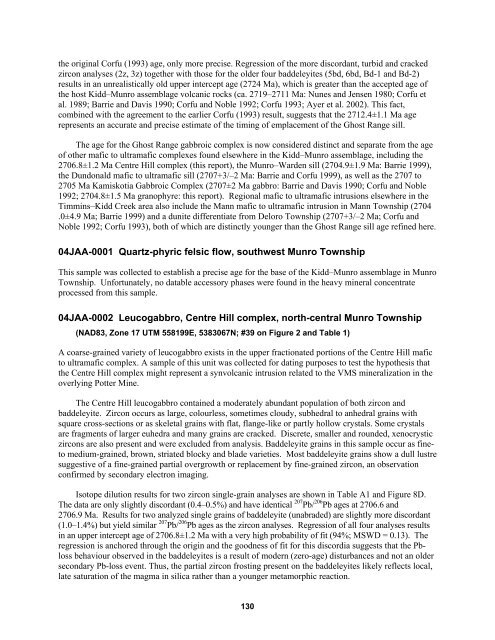Overview of Results from the Greenstone ... - Geology Ontario
Overview of Results from the Greenstone ... - Geology Ontario
Overview of Results from the Greenstone ... - Geology Ontario
You also want an ePaper? Increase the reach of your titles
YUMPU automatically turns print PDFs into web optimized ePapers that Google loves.
<strong>the</strong> original Corfu (1993) age, only more precise. Regression <strong>of</strong> <strong>the</strong> more discordant, turbid and cracked<br />
zircon analyses (2z, 3z) toge<strong>the</strong>r with those for <strong>the</strong> older four baddeleyites (5bd, 6bd, Bd-1 and Bd-2)<br />
results in an unrealistically old upper intercept age (2724 Ma), which is greater than <strong>the</strong> accepted age <strong>of</strong><br />
<strong>the</strong> host Kidd–Munro assemblage volcanic rocks (ca. 2719–2711 Ma: Nunes and Jensen 1980; Corfu et<br />
al. 1989; Barrie and Davis 1990; Corfu and Noble 1992; Corfu 1993; Ayer et al. 2002). This fact,<br />
combined with <strong>the</strong> agreement to <strong>the</strong> earlier Corfu (1993) result, suggests that <strong>the</strong> 2712.4±1.1 Ma age<br />
represents an accurate and precise estimate <strong>of</strong> <strong>the</strong> timing <strong>of</strong> emplacement <strong>of</strong> <strong>the</strong> Ghost Range sill.<br />
The age for <strong>the</strong> Ghost Range gabbroic complex is now considered distinct and separate <strong>from</strong> <strong>the</strong> age<br />
<strong>of</strong> o<strong>the</strong>r mafic to ultramafic complexes found elsewhere in <strong>the</strong> Kidd–Munro assemblage, including <strong>the</strong><br />
2706.8±1.2 Ma Centre Hill complex (this report), <strong>the</strong> Munro–Warden sill (2704.9±1.9 Ma: Barrie 1999),<br />
<strong>the</strong> Dundonald mafic to ultramafic sill (2707+3/–2 Ma: Barrie and Corfu 1999), as well as <strong>the</strong> 2707 to<br />
2705 Ma Kamiskotia Gabbroic Complex (2707±2 Ma gabbro: Barrie and Davis 1990; Corfu and Noble<br />
1992; 2704.8±1.5 Ma granophyre: this report). Regional mafic to ultramafic intrusions elsewhere in <strong>the</strong><br />
Timmins–Kidd Creek area also include <strong>the</strong> Mann mafic to ultramafic intrusion in Mann Township (2704<br />
.0±4.9 Ma; Barrie 1999) and a dunite differentiate <strong>from</strong> Deloro Township (2707+3/–2 Ma; Corfu and<br />
Noble 1992; Corfu 1993), both <strong>of</strong> which are distinctly younger than <strong>the</strong> Ghost Range sill age refined here.<br />
04JAA-0001 Quartz-phyric felsic flow, southwest Munro Township<br />
This sample was collected to establish a precise age for <strong>the</strong> base <strong>of</strong> <strong>the</strong> Kidd–Munro assemblage in Munro<br />
Township. Unfortunately, no datable accessory phases were found in <strong>the</strong> heavy mineral concentrate<br />
processed <strong>from</strong> this sample.<br />
04JAA-0002 Leucogabbro, Centre Hill complex, north-central Munro Township<br />
(NAD83, Zone 17 UTM 558199E, 5383067N; #39 on Figure 2 and Table 1)<br />
A coarse-grained variety <strong>of</strong> leucogabbro exists in <strong>the</strong> upper fractionated portions <strong>of</strong> <strong>the</strong> Centre Hill mafic<br />
to ultramafic complex. A sample <strong>of</strong> this unit was collected for dating purposes to test <strong>the</strong> hypo<strong>the</strong>sis that<br />
<strong>the</strong> Centre Hill complex might represent a synvolcanic intrusion related to <strong>the</strong> VMS mineralization in <strong>the</strong><br />
overlying Potter Mine.<br />
The Centre Hill leucogabbro contained a moderately abundant population <strong>of</strong> both zircon and<br />
baddeleyite. Zircon occurs as large, colourless, sometimes cloudy, subhedral to anhedral grains with<br />
square cross-sections or as skeletal grains with flat, flange-like or partly hollow crystals. Some crystals<br />
are fragments <strong>of</strong> larger euhedra and many grains are cracked. Discrete, smaller and rounded, xenocrystic<br />
zircons are also present and were excluded <strong>from</strong> analysis. Baddeleyite grains in this sample occur as fineto<br />
medium-grained, brown, striated blocky and blade varieties. Most baddeleyite grains show a dull lustre<br />
suggestive <strong>of</strong> a fine-grained partial overgrowth or replacement by fine-grained zircon, an observation<br />
confirmed by secondary electron imaging.<br />
Isotope dilution results for two zircon single-grain analyses are shown in Table A1 and Figure 8D.<br />
The data are only slightly discordant (0.4–0.5%) and have identical 207 Pb/ 206 Pb ages at 2706.6 and<br />
2706.9 Ma. <strong>Results</strong> for two analyzed single grains <strong>of</strong> baddeleyite (unabraded) are slightly more discordant<br />
(1.0–1.4%) but yield similar 207 Pb/ 206 Pb ages as <strong>the</strong> zircon analyses. Regression <strong>of</strong> all four analyses results<br />
in an upper intercept age <strong>of</strong> 2706.8±1.2 Ma with a very high probability <strong>of</strong> fit (94%; MSWD = 0.13). The<br />
regression is anchored through <strong>the</strong> origin and <strong>the</strong> goodness <strong>of</strong> fit for this discordia suggests that <strong>the</strong> Pbloss<br />
behaviour observed in <strong>the</strong> baddeleyites is a result <strong>of</strong> modern (zero-age) disturbances and not an older<br />
secondary Pb-loss event. Thus, <strong>the</strong> partial zircon frosting present on <strong>the</strong> baddeleyites likely reflects local,<br />
late saturation <strong>of</strong> <strong>the</strong> magma in silica ra<strong>the</strong>r than a younger metamorphic reaction.<br />
130

















